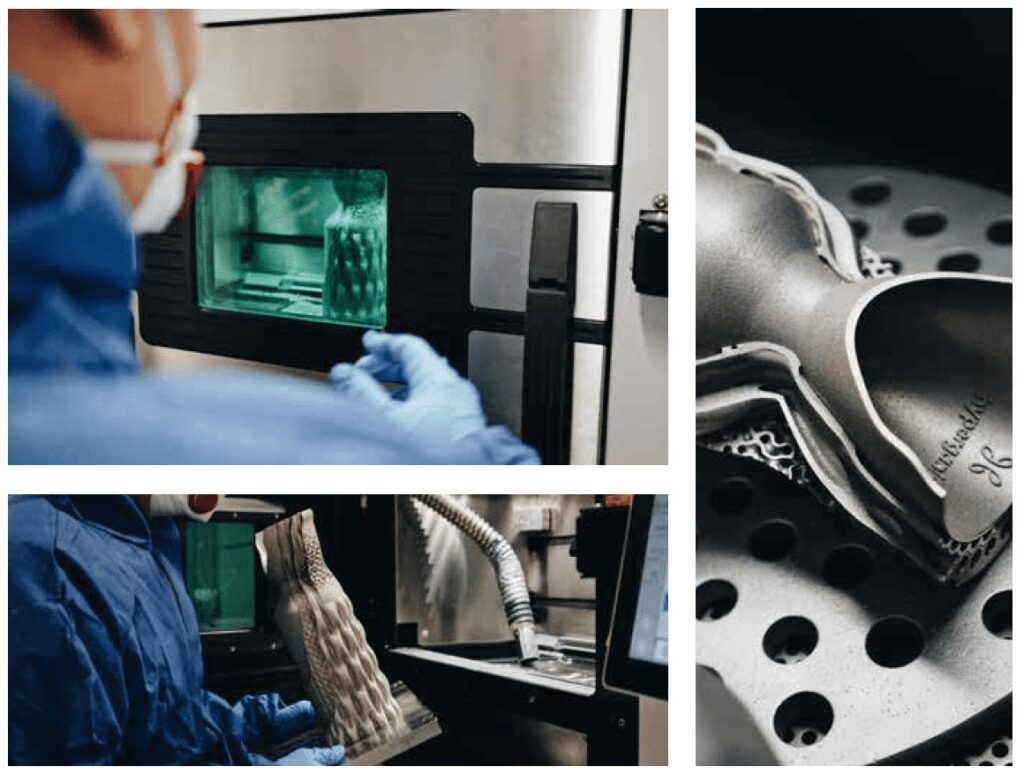The world of manufacturing is undergoing a fundamental transformation, quietly, and almost unnoticed. The result, however, will be dramatic. The way we design and produce physical objects will change more in the next 15 years than in the 100 years since the Industrial Revolution.
In this article, I am arguing that this ongoing shift has significant implications for Europe, today’s epicenter of manufacturing technology. In order to stay competitive, European companies and policymakers need to drive this transformation with haste.
The shift is driven by digital production technologies that have industrial 3D Printing, Additive Manufacturing, at their core. Additive Manufacturing has taken over the production of sophisticated aerospace parts, objects in the medical field, and is increasingly being applied to consumer products and many other verticals.
Additive Manufacturing today is used in boutique factories with a small number of machines and low production volumes. The produced objects, however, are vastly superior to traditionally manufactured products, so superior in fact, that entire verticals have already tipped, and industrial 3D Printing is now the only viable method for production.
As production volumes ramp up and the manufacturing techniques mature, we are beginning to see the familiar exponential curve which has guided the adoption of many disruptive technologies in the past decades.
It is therefore no surprise that Additive Manufacturing (AM) has a central role in China’s 2021 Five-Year Plan. In 2015, the government of Singapore established the National Additive Manufacturing Cluster (NAMIC), an agency tasked with establishing 3D Printing as a key pillar for their 15-year program to establish transformative technologies for the country’s economy.
Europe is the cradle of the Industrial Revolution, and to this day produces the world’s most advanced manufacturing technology. Thousands of “Hidden Champions” — Small to Medium Size Companies (SMEs) in Germany, Austria, Switzerland, Italy and many other European countries — are world leaders in creating the machines that form the foundation of our global production lines. When I visit a factory in China, chances are high, the owners proudly show off European machines as the foundation of their facility. The picture changes, however, when it comes to factories using AM.
Europe has its global players in the field of Additive. German 3D Printing pioneer Hans Langer, unbeknownst to many, has made it onto the Forbes List of Billionaires as founder and owner of his company EOS. Over the course of 30 years, EOS invented and pioneered many of the Additive Manufacturing methods which are transforming our industry. In 2016, GE’s acquisition of another trailblazer, Bavarian metal 3D Printing company Concept Laser, for 500 million EUR, made waves in the German press.
These headlines aside, the shift is happening quietly, and few people are familiar with the pace and profundity of this transformation — and its economic and geopolitical implications.
Europe today is utterly unprepared for a world where traditional manufacturing is supplanted by a different model. As the USA, China or Singapore are strategically preparing for this new future, Europe has currently no clear direction.
Furthermore, established AM players in Europe are starting to face stiff competition from US and Chinese companies.
I therefore believe it is imperative for Europe to get ready for this transformation. Here are 7 predictions for the future of manufacturing that will materialize over the next decade. I hope that spelling out these predictions can help foster a debate and can provide necessary guidance. Europe is fundamentally in a good starting position to be leading in this field — provided that political and business leaders are operating with a clear vision of the future.
#1 Forget Additive Manufacturing — Welcome to Digital Factories
Today’s industrial 3D Printers are islands in boutique factories. These printers will merge with other production processes into digital and automated production lines. Digital Factories will be complex and expensive. The best mental model for a Digital Factory is the microchip industry. Microchip “Fabs” are complex multi-billion Euro production facilities that produce the most sophisticated objects we humans have ever created, integrated circuits. Digital Factories for physical products will go the same way. We need to pilot these factories and be aware of the scope of the undertaking.
#2 Digital Factories Will Have No Workers
We already have a high automation level in traditional manufacturing in Europe. However, with the introduction of Digital Manufacturing, we will transition to “Lights Out Factories” that are devoid of human workers (and therefore do not require lights to be on in the building, hence the name). Many of the new production techniques will have to be sealed and humans are a source of contaminants and errors. Advanced 3D Printing will be combined with other techniques, such as surface coating objects with electronic circuits, solar cells or displays. Since Additive Manufacturing can create entirely enclosed functional groups, there is no need to assemble objects, just like there is no need for human assembly in microchip manufacturing.
#3 One Factory for Many Different Products
Factories are currently highly specialized “machines” that are purpose-built for the product they produce. With Digital Manufacturing, we will transition to a paradigm, where a standardized process will be able to output entirely different objects. In Digital Manufacturing, the production process is flexible. The resulting objects can have different use cases. Factories will be focused on certain types of materials, size or precision constraints, but they will be independent of the type of product.
The implications for traditional specialized companies in the field of manufacturing will be dramatic, as they will become superfluous unless they adapt to this changing world. It may sound far-fetched given the success of supplier companies in the traditional space today, but like with all things digital, the transformation will be abrupt and brutal.
#4 Physical Trade Will Peak and Decline
As Digital Factories become more widespread, the manufacturing of the products can move closer to the consumer. In an effort to reduce dependencies on far-flung supply chains and driven by the fact that a “Lights Out” factory doesn’t need cheap labour to be commercially viable, entrepreneurs will establish manufacturing hubs close to large population centres.
Digital Physical Products, products that are conceived digitally, traded digitally and produced physically — on demand close to the end customer — will supplant traditional trade.
On the other hand, Digital Factories will progressively become more complex, and therefore expensive, which will result in some level of centralization. It will be interesting to see how these two opposing trends play out. The winners will be large cities that are also trade hubs, a fact underlined by Singapore’s strategy. It is clear though, that physical trade is at its peak today and investment in container terminals and other large-scale projects are dealing with at best a zero-sum scenario, where one region’s increase has to come at another region’s decline.

#5 Parts will become superfluous
Trade today mostly deals with the components that make up an object. Factories are giant logistics hubs where parts are delivered on one side and assembled products exit on the other side. In a world of Digital Manufacturing entire machines are going to be produced in one sophisticated integrated production process. These objects will be self-enclosed and require no assembly, and therefore no screws or parts.
This will have a dramatic impact on suppliers, unless they adopt a digital model to intellectual property and trade.
#6 Trade will become digital
Instead of shipping the physical parts that make up a product, suppliers will increasingly provide intellectual property in digital form that is then used in digital assembly of the product. In this paradigm the part is delivered as a software algorithm and not as a physical object that is shipped for assembly. As digital trade is frictionless across borders, European companies must improve their digital proficiency and train their workforce.
#7 Innovation in physical products will become exponential
Part of the challenge of product innovation is that physical supply chains are complicated. Changes to a product require significant reengineering and modification of the tools that create the part. In Digital Production, these sources of friction to innovation will go away. Since the production process is flexible and non-specific to the shape of one particular object, products can be adapted quickly and customized to specific use cases. A 3D Printer can be used to produce the same part over and over again, or a different part every time. Therefore, new ideas and feedback from product use can be fed back to engineering quickly and effectively. As a result, product innovation can happen at unprecedented pace. This, however, also implies that traditionally produced objects will quickly be obsoleted by products which are created under this new paradigm. A traditionally manufactured and engineered product will not be able to compete.
European business leaders need to prepare for this new world. In the coming years, we require significant investment in industrial 3D Printing capabilities in each company that creates physical objects. Every company needs to figure out, what this new paradigm means for their future and how to become a leader in this space. It is dangerous to wait and see “how the market evolves”. Transformations like these happen on an exponential curve. European entrepreneurs must work together to trial Digital Factories and build pilot facilities to test out and streamline processes. Unfortunately, many European SMEs operate under an incremental improvement model and cooperation between different sectors is limited. However, this transformation is not an incremental process. It requires upfront investment, interdisciplinary cooperation, and a will to shape the future boldly and actively.
European policymakers must evaluate what this transformation means for Europe on the macro level. What will happen to trade and how does it affect Europe’s geopolitical position? How can Europe’s digital infrastructure be improved? How can large scale Digital Manufacturing and trade of Digital Physical Products be made a central pillar of European policy? Europe must lead or risk becoming irrelevant.
Can European politics come up with a framework for the safe and legal transaction of international digital trade of physical products?
How can Europe stay attractive for companies in a world of frictionless digital trade, which makes it easy to move assets around?
Can Europe become the region where we shape the future of engineering, production and trade in the same way we did 100 years ago?
As Silicon Valley Tech Pioneer Alan Kay famously said: “The best way to predict the future is to invent it”.
Lin Kayser
Chair Advanced Manufacturing
Council, EU Tech Chamber























